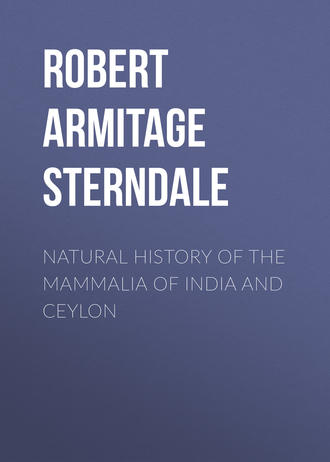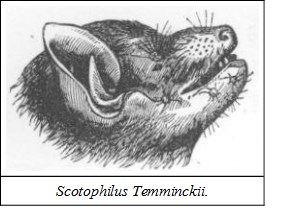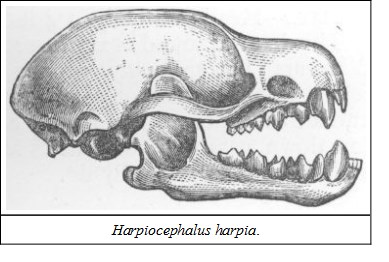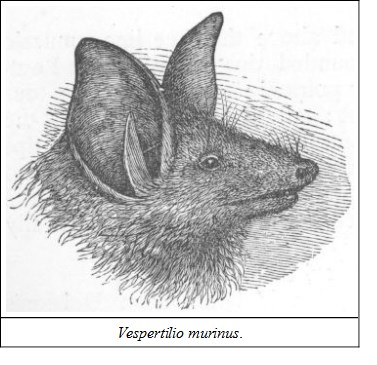 полная версия
полная версияNatural History of the Mammalia of India and Ceylon
HABITAT.—Khasya Hills.
DESCRIPTION.—Muzzle broad and flat, with large labial development; ears broad, triangular, broadly rounded off above; tragus broad and square; fur long and dense, uniformly sooty brown, with greyish tips; membranes, nose, ears and lips black.
SIZE.—Head and body 1-1/10 inch; tail, 1 inch.
NO. 81. VESPERUGO AFFINISHABITAT.—Burmah (Bhamo, Yunan).
DESCRIPTION (apud Dobson).—Head flat; upper labial glands so developed as to cause a deep depression between them on the face behind the nostrils; ears broad as long from behind; the outer margin extends from the tip to its termination near the corner of the mouth without emargination or lobe; tragus broad; inner margin straight; outer convex; small triangular lobe at base. Fur chocolate brown above, lighter on head and neck; beneath dark brown with lighter tips on the pubes, and along the thighs dirty white or pale buff.
SIZE.—Head and body, 1·9 inch; tail, 1·65 inch.
There is a good figure of the head of this bat in Dobson's Monograph; it was obtained by Dr. J. Anderson at an elevation of 4500 feet at Bhamo.
NO. 82. VESPERUGO PACHYOTISDESCRIPTION.—"This species is readily distinguished by the peculiar thickness of the lower half of the outer side of the ear-conch, which appears as it were excavated out of the thick integument of the neck; tragus short, curved inwards."—Dobson.
This bat is more fully described with three illustrations in Dobson's Monograph; he does not mention where it is found, so it may or it may not be an Indian species.
NO. 83. VESPERUGO ATRATUS Syn.—NYCTICEJUS ATRATUSHABITAT.—Darjeeling.
DESCRIPTION.—Head broad; muzzle obtuse; upper labial glands largely developed; ears large, oval, with rounded tips, which in the natural position of the ears appear acute, owing to the longitudinal folding of the outer side of the conch on the inner, commencing at and almost bisecting the tip (Dobson). Fur long, dense and black; Jerdon says rich dark brown; paler beneath.
SIZE.—Head and body, 1·9 inch; tail, 1·8 inch.
NO. 84. VESPERUGO TICKELLIHABITAT.—Chybassa, Jashpur, and Sirguja.
DESCRIPTION.—Head broad and flat; labial glands developed; ears moderate, rounded above; outer edge straight, emarginate opposite base of tragus, terminating in a small lobe; tragus lunate; tail long; last vertebra free. The face is more clad with fur than in other species of this genus; fur of the body pale, straw brown above, pale buff beneath. For a fuller description and illustration, see Dobson's Monograph.
SIZE.—Head and body, 1·65 inch; tail, 2 inches.
NO. 85. VESPERUGO PACHYPUSHABITAT.—Darjeeling, Tenasserim, and Andaman Islands.
DESCRIPTION.—Crown of head very flat; ears short, triangular, with broadly rounded tips, tragus short; under surface of the base of the thumb and soles of the feet with broad fleshy pads; wings rather short; fur fine and dense, above reddish brown, paler beneath.
SIZE.—Head and body, 1·75 inch; tail 1 inch.
NO. 86. VESPERUGO ANNECTANSHABITAT.—Naga Hills and Assam.
DESCRIPTION.—Muzzle sharper; face hairy; ears pointed; tragus long; colour dark brown; illustration in Dobson's Monograph.
SIZE.—About 2 inches; tail, 1·6 inch.
Unites the appearance of a Vespertilio to the dentition of Vesperugo.
NO. 87. VESPERUGO DORMERIHABITAT.—Southern India and Bellary Hills.
DESCRIPTION.—Head flat; ears shorter, triangular, with rounded tips; tragus with a small triangular lobe near base of outer margin; fur brown, with ashy tips above, darker brown below, with the terminal third of the hairs white. Dentition approaches the next genus, there being only one pair of unicuspidate upper incisors placed, one by each upper canine.
NO. 88. (VESPERUGO) SCOTOPHILUS SEROTINUS Syn.—VESPERUGO SEROTINUSThe Silky Bat (Jerdon's No. 35)HABITAT.—Europe, but extending through Asia to the Himalayas, Beluchistan and Kashmir.
DESCRIPTION.—Ears shorter than head, widely separate, ovate, angular, projecting forward, terminating in a convex; lobe ending on a level with the corner of the mouth; tragus twice the length of its breadth, semi-cordate; fur deep bay or chestnut brown; above fulvous, grey beneath; hairs of back long and silky, but the colour of the fur varies considerably.
SIZE.—Head and body, 2½ inches; tail, 2; wing expanse, 13.
This is a rare bat in India, though Captain Hutton has procured it at Mussoorie. In England it is not uncommon even near London; it flies steadily and rather slow, and is found in ruins, roofs of churches, and sometimes old hollow trees.
NO. 89. (VESPERUGO) SCOTOPHILUS LEISLERI Syn.—VESPERUGO LEISLERIThe Hairy-armed Bat (Jerdon's No. 36)HABITAT.—Himalayas.

DESCRIPTION.—Ears short, oval, triangular; tragus short, rounded at tip; membrane attached to base of outer toe; all toes short; membrane over the arms very hairy, some cross-lines of hair on the interfemoral membrane; fur long, deep fuscous brown at base, chestnut at the tip; beneath greyish brown.—Jerdon.
SIZE.—Head and body, 2¼ inches; tail, 3¾; expanse, 11½.
SCOTOPHILUS PACHYOMUS(Jerdon's No. 37)Synonymous with his No. 35; see Dobson's Monograph.
NO. 90. (VESPERUGO) SCOTOPHILUS COROMANDELIANUS Syn.—VESPERUGO ABRAMUS; VESPERTILIO COROMANDELICUSThe Coromandel Bat (Jerdon's No. 38)HABITAT.—India generally, Burmah and Ceylon.
DESCRIPTION.—Ears triangular, rather large; outer margin straight or slightly concave; tragus lunate; feet small; wing membrane attached to the base of the toes; fur short, above dingy brown, the hairs tipped with a lighter tinge, paler beneath.
SIZE.—2½ inches, including tail, which is about 1-1/8; wing expanse, 7½.
This is a very common little bat, akin to the English Pipistrelle, and is found everywhere in roofs, hollow bamboos, &c.
NO. 91. (VESPERUGO) SCOTOPHILUS LOBATUS Syn.—VESPERUGO KUHLIIThe Lobe-eared Bat (Jerdon's No. 39)HABITAT.—India generally.
DESCRIPTION.—Ears small, triangular; the base of the margin very convex forward; a triangular lobule above the base of the outer margin; tragus short and uniform in width; a short muzzle; wings from the base of the toes; feet small; calcaneum long; tip of tail free; fur blackish yellow above, ashy beneath.
SIZE.—Two and a-half inches, of which the tail is 1¼; expanse 7-2/3. Jerdon, quoting Tomes, states that this is the same as V. Abramus, but that is the synonym of the last species.
GENUS SCOTOPHILUSMuzzle short, bluntly conical, devoid of hair; ears longer than broad; tail shorter than the head and body; wing membrane attached to the base of the toes.
Dentition: Inc., 1—1/6; can., 1—1/1—1; premolars, 1—1/2—2; molars 3—3/3—3.
Jerdon's formula gives upper incisors 4.
NO. 92. SCOTOPHILUS FULIGINOSUSThe Smoky Bat (Jerdon's No. 40)HABITAT.—Central Nepal.
DESCRIPTION (apud Hodgson).—"Feet very small, included in the wing membrane nearly to the end of the toes; ears acutely pointed, shorter than the head; muzzle groved, nudish; face sharp; rostrum somewhat recurved; wholly sooty brown; a little smaller than Vesp. formosa."
I cannot find this bat mentioned by any other author, and Jerdon says it does not seem to be recognised.
NO. 93. SCOTOPHILUS TEMMINCKII Syn.—NYCTICEJUS TEMMINCKII (Jerdon)
HABITAT.—India generally; Burmah and Ceylon.
DESCRIPTION.—Ears short, rounded and narrow; tragus narrow, curved and pointed inwards; muzzle thick, blunt and conical; the fur varies, sometimes dark olive brown, fulvous beneath, and occasionally chestnut, with a paler shade of yellow below.
SIZE.—Four and a-half inches, of which the tail is 1½; expanse, 13.
A very common species, appearing early in the evening. Horsfield says of it that it collects by hundreds in hollow trees, and feeds chiefly on white ants.
NO. 94. SCOTOPHILUS HEATHIIHABITAT.—India and Ceylon (Rajanpore, Punjab).
DESCRIPTION.—Similar to the above, but longer in all its measurements (Dobson). Judging from drawings, the head and muzzle of this are more in a line than in the last species, the ears project forward, and are also larger, the tragus especially, and there is a greater width between the ears.
SIZE.—Five inches, of which the tail is 2.
NO. 95. SCOTOPHILUS EMARGINATUSHABITAT.—India; precise locality unknown.
DESCRIPTION.—Head broad and flat; muzzle obtuse and thick; ears long and large, with rounded tips turning outwards; tragus short; thumb long with a strong claw; wing membrane quite devoid of hair, except on the interfemoral membrane, which is half covered; fur tricolored, first dark chestnut, buff, and then yellowish brown.
SIZE.—Head and body, 2-1/10 inches; tail, 2 inches.
NO. 96. SCOTOPHILUS ORNATUS Syn.—NYCTICEJUS ORNATUSHABITAT.—India and Burmah.
DESCRIPTION.—Head broad; muzzle short; ears triangular, erect, with rounded tips, and broadly rounded lobe at the base; tragus narrow, semi-lunate, curved towards the front; fur a light Isabelline brown, spotted with white; a white spot on the centre of the forehead, and from the back of the head down the spine for two-thirds of its length a narrow white streak; on each side of the body two white patches; a broad white collar, or rather demi-collar, from one ear spot to the other, passing under the throat. Dr. Dobson says the position of these patches is very constant, but the size varies, being greatest in individuals of a pale rusty red colour, and these he found always to be males.
SIZE.—Head and body, 3 inches; tail, 2 inches; expanse, 15.
NO. 97. SCOTOPHILUS PALLIDUSHABITAT.—Mian Mir, Lahore.
DESCRIPTION.—Head and muzzle as in S. Temminckii; ears slightly shorter than the head; internal basal lobe convex, evenly rounded; tip broadly rounded off; tragus moderately long and rounded at the tip; a prominent triangular lobe at base. Wing membrane from base of toes; lobule at the heel very narrow and long; last rudimentary caudal vertebra free; fur of the body, wings, and interfemoral membrane pale buff throughout.
SIZE.—Head and body, 2 inches; tail, 1·4 inch.
NOCTULINIA NOCTULA(See ante: Vesperugo noctula—Jerdon's No. 41.)NYCTICEJUS HEATHIILarge Yellow Bat (Jerdon's No. 42)(See ante: Scotophilus Heathii.)NYCTICEJUS LUTEUSThe Bengal Yellow Bat (Jerdon's No. 43)NYCTICEJUS TEMMINCKIIThe Common Yellow Bat (Jerdon's No. 44)Both the above (Nos. 43 and 44) are, according to Dr. Dobson, synonymous with Scotophilus Temminckii, which see.
NYCTICEJUS CASTANEUSThe Chestnut Bat (Jerdon's No. 45)This is also a variety of Scotophilus Temminckii.
NYCTICEJUS ATRATUSThe Sombre Bat (Jerdon's No. 46)(See ante: Vesperugo atratus.)NYCTICEJUS CANUSThe Hoary Bat (Jerdon's No. 47)(See ante: Vesperugo lobatus.)NYCTICEJUS ORNATUSThe Harlequin Bat (Jerdon's No. 48)(See ante: Scotophilus ornatus.)NO. 98. NYCTICEJUS NIVICOLUSThe Alpine Bat (Jerdon's No. 49)HABITAT.—Sikim.
DESCRIPTION.—"Head and body above uniform light brown with a slight yellowish shade; underneath, from the throat to the vent, dark grey with a brownish tint, lighter on the sides of the throat. Ears long, attenuated to an obtuse point."—Jerdon.
SIZE.—Head and body, 3 inches; tail, 2 inches; expanse, 19 inches.
This bat was described by Hodgson ('Ann. Mag. Nat. Hist.' 1855), but there is some doubt about it, and it has been classed as a Lasiurus and also with Scot. ornatus and Vesp. formosa, but Jerdon thinks it a distinct species. I cannot find any mention of it in Dobson's monograph.
GENUS HARPIOCEPHALUSThis is also the genus Murina of Gray. Dr. Dobson explains his acceptance of the former term in the following way: that he first accepted Murina on the score of priority in a paper showing that Harpiocephalus and Murina must be united in a single genus; but finding afterwards that Gray had founded Murina on a specimen of what he believed to be Vesp. suillus (Temm.), but which was in reality a specimen of a very different species from Darjeeling, belonging to the same section of the genus as Vespertilio harpia (Temm.) the type of his genus Harpiocephalus, it remained therefore either to discard both names or to retain Harpiocephalus, in which course he was supported by Professor Peters, to whom he mentioned the facts.
Horsfield's genus Lasiurus is included in this one, though Jerdon considers it distinct from Murina.
Muzzle elongated, conical; nostrils prominent, tubular; produced beyond the upper lip, opening laterally or sublaterally, emarginate between; crown of the head scarcely raised above the face line; ears thin, generally covered with glandular papillæ; tragus long, attenuated towards the tip, and inclined outwards; thumb very large, with a large, strongly curved claw; wings around interfemoral membrane very hairy.—Dobson.
Dentition: Inc., 2—2/6; can. 1—1/1—1; premolars, 2—2/2—2; molars, 3—3/3—3.
NO. 99. HARPIOCEPHALUS HARPIALasiurus Pearsonii (Horsfield) (Jerdon's No. 50)HABITAT.—Darjeeling and Khasia hills.
DESCRIPTION.—"Fur above very soft, silky, and rather long; colour on the head, neck, and shoulders brownish grey, with a ferruginous cast, variegated with whitish hairs; the rest of the body above, with the base of the membrane, the thighs and the interfemoral membrane, have a deep bay or reddish-brown hue, and delicate hairs of the same colour are scattered over the membrane and project from its border; the body underneath is thickly covered with a grey fur, which is paler on the breast and body; the interfemoral membrane marked with regularly parallel transverse lines" (Horsfield). Ears ovoid; tragus rather long, nearly straight, acute at the tip (Jerdon). Muzzle rather short, obtusely conical; end of nose projecting considerably beyond the lip, consisting of diverging tubular nostrils opening laterally, with a slight emargination between each (Dobson).

SIZE.—Head and body, 3 inches; tail, 1½ inch; expanse, 14. Hodgson, who procured it at Darjeeling, writes of it: "Entire legs and caudal membrane clad in fur like the body, which is thick and woolly. Colour bright rusty above; sooty below, the hairs tipped with hoary."
This bat is, for its size, one of the most powerfully armed with teeth. The skull reminds one of that of a dog or hyæna in miniature; the teeth are very stout, the canines blunt and conical, and the cusps of the molars short and blunt, well coated with enamel; the jaws are correspondingly muscular and adapted to the food of the animal, which consists of hard-shelled beetles, the crushed cases of which have been found in its stomach.
NO. 100. HARPIOCEPHALUS (MURINA) SUILLUSThe Pig-Bat (Jerdon's No. 51)HABITAT.—Darjeeling (Jerdon); Malayan archipelago.
DESCRIPTION.—Muzzle narrow, elongated; nostrils very prominent, which, viewed from below, resemble in shape a small hour-glass placed horizontally at the extremity of the muzzle; ears moderate, shorter than the head, rounded at the tips; tragus moderately long, attenuated above and slightly curved outwards; fur light greyish-brown; extremities dark brown; beneath light greyish-brown throughout.—Dobson.
SIZE.—Head and body, 1¾ to 2 inches; tail, 1½ inch; expanse 9 to 10.
NO. 101. HARPIOCEPHALUS AURATUSHABITAT.—Thibet.
DESCRIPTION.—Head and muzzle as in H. suillus, but the nostrils are differently shaped; each nostril forms a distinct tube directed sublaterally with a circular aperture marked by a very small notch on the outer and upper margin (Dobson). The whole body is thickly clad; the fur on the back is black, with bright golden yellow tips; the back of the fore-arm covered with short golden hair; the hair of the under parts black with silvery tips, whiter on the lower jaw, neck and pubis; the interfemoral membrane is covered with very long hair, which forms a fringe along its free margin extending on the legs and feet, and projecting beyond the toes; underneath short silvery hair.
SIZE.—Head and body 1·4 inch; tail 1·2.
NO. 102. HARPIOCEPHALUS GRISEUSHABITAT.—Jeripani, N.W. Himalayas.
DESCRIPTION.—Head and muzzle as in H. suillus; fur above dark brown, with yellowish-brown extremities; beneath similar, but with the extreme points of the hairs ashy.
SIZE.—Head and body, 1·4 inch; tail 1 inch.
This bat was found near Mussoorie by Captain Hutton, who writes that it occurs, but sparingly, on the outer southern range of hills at 5500 feet. It skims close to the ground, and somewhat leisurely over the surface of the crops and grass; and one which flew into his room kept low down, passing under chairs and tables, instead of soaring towards the ceiling, as bats generally do.
NO. 103. HARPIOCEPHALUS LEUCOGASTERHABITAT.—N.W. Himalayas, Thibet.
DESCRIPTION.—Head and muzzle as in H. harpia; fur long and dense, above brown with grey bases; underneath whitish; sides light brown. It differs from the next species by a small projecting tooth on the inner margin of the ear conch, by the smaller size of the first upper premolar, and by the colour.—Dobson.
SIZE.—Head and body, 1·9 inch; tail 1·5.
NO. 104. HARPIOCEPHALUS CYCLOTISHABITAT.—Darjeeling, Ceylon.
DESCRIPTION.—Similar to the last, but with round ears; fur bicoloured, the hairs being dark brown at the base, with bright ferruginous tips; below pale brown; the upper surface of the interfemoral membrane and back of the feet covered with hair, which also extends beyond the toes; the first premolar in the upper jaw nearly equal in size to the second, whereas in the last species it is only about three-fourths.
SIZE.—Head and body, 1·7 inch; tail, 1·5.
GENUS KERIVOULADESCRIPTION.—Muzzle long and narrow; skull very concave between the nasal bones and the vertex, so that the crown appears considerably vaulted; ears funnel-shaped and semi-transparent; tragus very long, narrow and pointed; wings very wide; tail longer than head and body, wholly contained within the interfemoral membrane.
Dentition: Inc., 2—2/6; can., 1—1/1—1; premolars, 3—3/3—3; molars, 3—3/3—3.
The generic name of this bat is composed of two Singhalese words—kehel or kela, the plantain, and voulha, which is the Singhalese for bat, the specimen on which Gray founded his genus being the following:—
NO. 105. KERIVOULA PICTAThe Painted Bat (Jerdon's No. 53)HABITAT.—India generally, Burmah and Ceylon.
DESCRIPTION.—"Fur fine, woolly; above yellowish-red or golden rufous, beneath less brilliant and more yellow; wing membranes inky black, with rich orange stripes along the fingers extending in indentations into the membrane."—Jerdon.
Ears moderate, laid forwards; the tips reach midway between the eyes and the middle of the muzzle; tragus very long and straight; thumb short; wings to the base of the toes.
SIZE.—Head and body, 1½ inch; tail, 1·6 inch; expanse about 10 inches.
This beautiful little bat is found all over India, but is not common; it is occasionally caught in plantain gardens, as it resorts to the leaves of that tree for shelter during the night, and may sometimes be discovered in the folds of a leaf. As Jerdon remarks, it looks more like a butterfly or a moth when disturbed during the day time. Dr. Dobson pertinently observes that the colours of this bat appear to be the result of the "protective mimicry" which we see so often in insects, the Mantidea and other genera, the colours being adapted to their abiding places. He alludes to Mr. Swinhoe's account ('P. Z. S.,' 1862, p. 357) of an allied species:—"The body of this bat was of an orange yellow, but the wings were painted with orange yellow and black. It was caught suspended head downwards on a cluster of the round fruit of the longan tree. (Nephelium [Scytalia] longanum) [the ash phul of Bengal]. Now this tree is an evergreen, and all the year through some portion of its foliage is undergoing decay, the particular leaves being in such a stage partially orange and black; this bat can therefore at all seasons suspend from its branches and elude its enemies by its resemblance to the leaf of the tree." This bat was named by Pallas Vespertilio pictus. Boddaert in 1785 termed it Vesp. kerivoula, and Gray afterwards took the second specific name for that of the genus, leaving the first as it is.
KERIVOULA PALLIDA(Jerdon's No. 54.)This is synonymous with Vespertilio formosus, which see further on, it is the same as the Kerivoula formosa of Gray.
NO. 106. KERIVOULA PAPILLOSA(Jerdon's No. 55.)HABITAT.—Java, but said by Jerdon to have been found in Calcutta and Ceylon.
DESCRIPTION.—Fur fine woolly, long, bicoloured; above light shining brown, paler below; the free edge of the interfemoral membrane margined with small papillæ.
NO. 107. KERIVOULA HARDWICKIIHABITAT.—India (Assam—Shillong, Khasia hills).
DESCRIPTION.—Same size as K. picta, but ears larger; fur uniformly dark above and below, with shining greyish-brown extremities.
GENUS VESPERTILIOMuzzle long; ears often larger than the head, oval, apart; tragus long, acute; crown of head vaulted; feet moderate; wing membrane from base of toes; tail, wholly included in interfemoral membrane, less than length of head and body.
Dentition: Inc., 2—2/6; can., 1—1/1—1; premolars, 3—3/3—3; molars, 3—3/3—3.
NO. 108. MYOTIS (VESPERTILIO) MURINUS(Jerdon's No. 61.)HABITAT.—N.W. Himalayas.

DESCRIPTION.—Fur above light reddish or smoke brown beneath dusky white, the base of the hairs dark.
SIZE.—Head and body, 2½ inches; tail, 2 inches; expanse, 15 inches.
NO. 109 & 110. MYOTIS THEOBALDI and MYOTIS PARVIPES(Jerdon's Nos. 62 & 63.)Both these appear to be closely allied to the pipistrelle of Europe, and are stated to have been found at Mussoorie and in Kashmir.
NO. 111. VESPERTILIO LONGIPESHABITAT.—Kashmir (caves of Bhima Devi, 6000 feet).
DESCRIPTION.—Wings from the ankles; feet very large, about one-fourth the length of the head and body; fur black above, underneath black with whitish tips.
SIZE.—Head and body, 1·75 inch; tail, 1·45 inch.
NO. 112. VESPERTILIO MYSTACINUSHABITAT.—Himalayas.
DESCRIPTION.—Muzzle narrow; skull vaulted; ears as long as head, wings from base of toes; fur dark brown.
NO. 113. VESPERTILIO MURICOLAHABITAT.—Himalayas, Arracan.
DESCRIPTION.—Similar to the above, but may be distinguished by a small lobe behind the heel, by the deep emargination of the upper third of the outer margin of the ear; by the intensely black colour of the fur and membranes, and by its small size.—Dobson.
SIZE.—Head and body, 1·6 inch; tail, 1·55 inch.
NO. 114. VESPERTILIO MONTIVAGUSHABITAT.—Burmah, Hotha, Yunan.
DESCRIPTION.—Head slightly elevated above the face line; muzzle obtuse; ears narrow, tapering, with rounded tips slightly turned outwards; tragus long, narrow, and acutely pointed; feet very small; toes two-thirds the length of the whole foot; tail wholly contained in the membrane; wings from base of toes; fur dark brown above, the tips paler and shining, beneath much darker, almost black, with ashy tips to the hairs; face much covered with hair, which almost conceals the eyes; the tip of the nose alone naked; wing membranes partially covered with fur.
SIZE.—Head and body, 1·8 inch; tail, 1·6 inch.
This bat, of which the above description is taken from Dobson's monograph, was obtained by Dr. J. Anderson during the Yunan Expedition.
NO. 115. VESPERTILIO MURINOIDESHABITAT.—N.W. Himalayas (Chamba), 3000 feet.



